What Size Art Prints Work Best for Every Room?
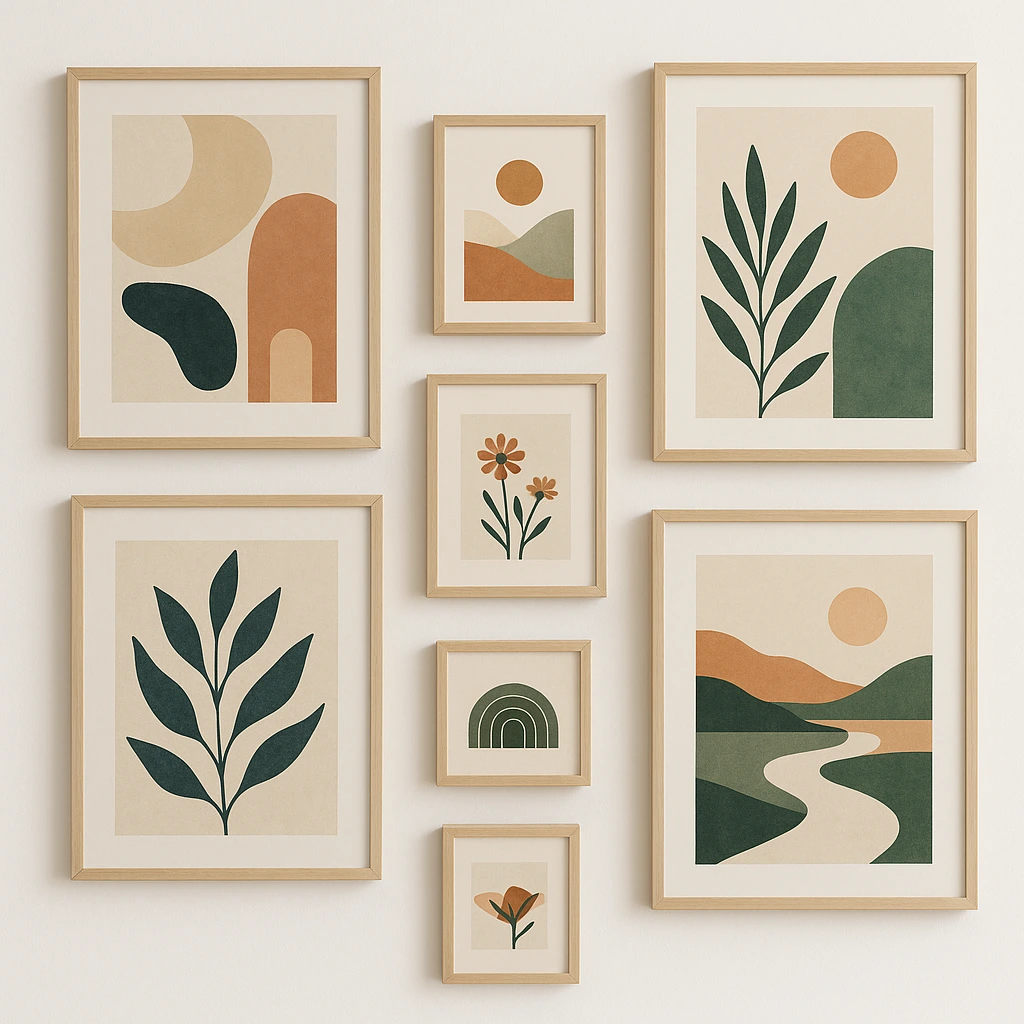
What Size Art Prints Work Best for Every Room?
Choosing the right size art print for your space can dramatically transform a room’s atmosphere. Whether you’re decorating a cozy bedroom or a spacious living room, the dimensions of your wall art play a crucial role in creating visual balance and expressing your personal style. Small prints typically range from 5″x7″ to 11″x14″, medium prints from 16″x20″ to 18″x24″, and large prints start at 24″x36″ and beyond. The perfect size depends not only on your available wall space but also on the statement you want to make.
In this guide, you’ll learn how to select ideal print sizes for different rooms, understand standard dimensions, and discover professional techniques for creating visually appealing wall displays that enhance your home’s character and charm.
Understanding standard art print sizes
Knowing standard art print sizes simplifies the entire process of shopping for, framing, and designing with wall art. These standardized dimensions ensure compatibility with commonly available frames and make planning your space much more straightforward.
- 5″x7″ – Perfect for small areas, shelves, or as part of gallery walls
- 8″x10″ – Popular for personal photos and smaller artworks
- 11″x14″ – Versatile medium-small size that works in various spaces
- 16″x20″ – Medium-sized print suitable for moderate wall spaces
- 18″x24″ – Larger medium print that creates more visual impact
- 24″x36″ – Statement piece size for larger walls
- 30″x40″ – Oversized art that becomes a room’s focal point
Remember that your chosen print medium can significantly alter the actual wall footprint. Canvas prints typically add minimal extra dimension, while framed and matted pieces may increase the overall size by several inches on each side. For practical purposes, matching your artwork to standard frame sizes will save you money and hassle compared to custom framing options.
Room-by-room art print sizing guide
The ideal art print size varies dramatically depending on which room you’re decorating. Each space has its own proportions, furniture, and purpose that influence what dimensions will work best.
Living room
As the central gathering space in most homes, living rooms often benefit from statement pieces that anchor the room. For walls above sofas, choose artwork that spans approximately two-thirds to three-quarters of your furniture’s width.
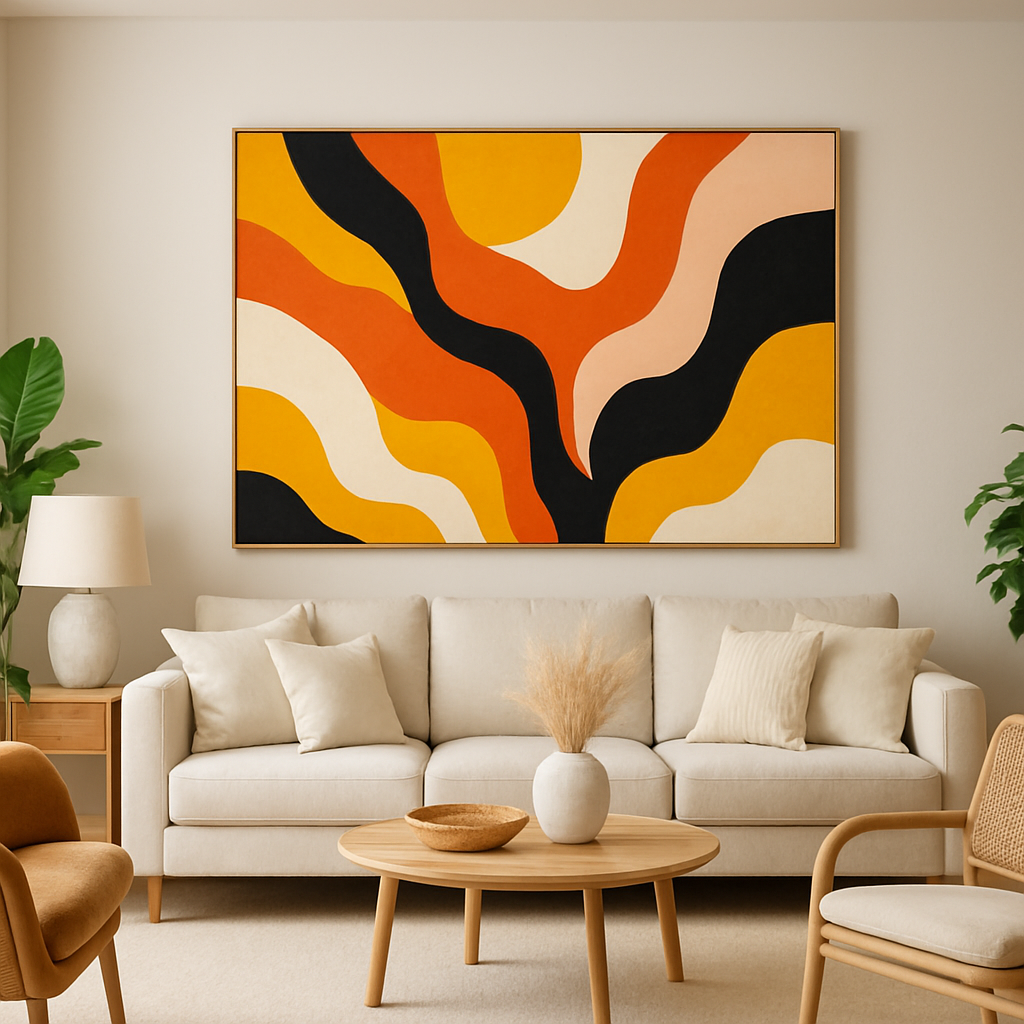
For instance, a standard 84″ sofa would pair beautifully with artwork around 56″ wide, whether that’s a single large piece or a collection forming that width.
Oversized prints (30″x40″ or larger) work wonderfully as focal points in spacious living areas. Alternatively, create a gallery wall using a combination of small and medium prints for a more eclectic, collected look that can grow over time.
Bedroom
In bedrooms, the wall above the headboard typically calls for either one substantial piece or a symmetrical arrangement of medium prints. For queen beds (approximately 60″ wide), consider artwork around 36″-45″ in total width.
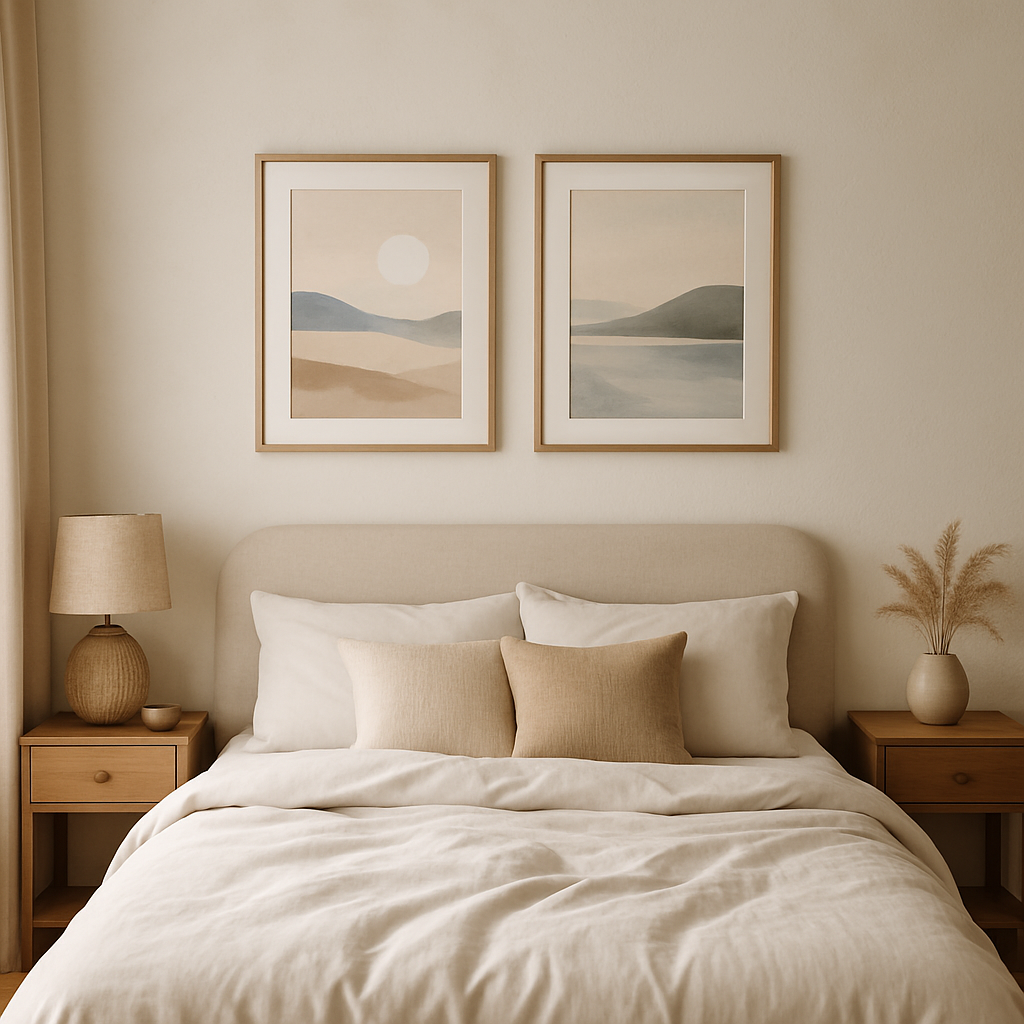
In smaller bedrooms, avoid overwhelming the space with prints that are too large – instead, opt for medium pieces (16″x20″ or 18″x24″) that complement rather than dominate.
Vertical prints on side walls can help enhance ceiling height in bedrooms with lower ceilings, creating the illusion of a taller, more spacious room.
Dining room & kitchen
Dining rooms benefit from medium-sized horizontal prints that mirror the shape of the dining table below.
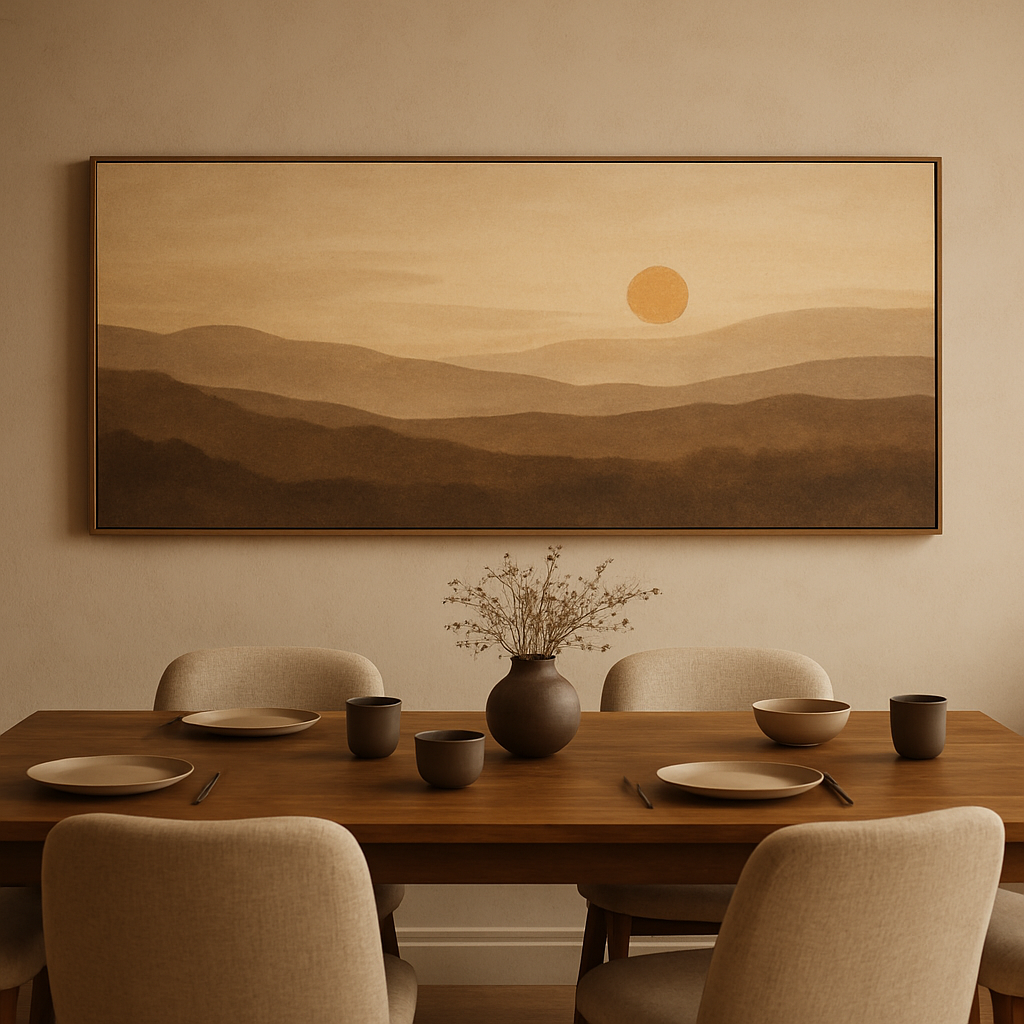
A standard 72″ dining table pairs well with artwork approximately 48″ wide above it. In kitchens, where wall space is often limited by cabinets and appliances, smaller prints (8″x10″ or 11″x14″) work best, either individually or grouped in sets of two or three.
For narrow kitchen walls, consider vertical prints that maximize the use of available space without overwhelming the functional nature of the room.
Entryway, office & bathroom
Entryways benefit from medium vertical prints (18″x24″) that draw the eye upward and create a welcoming first impression.
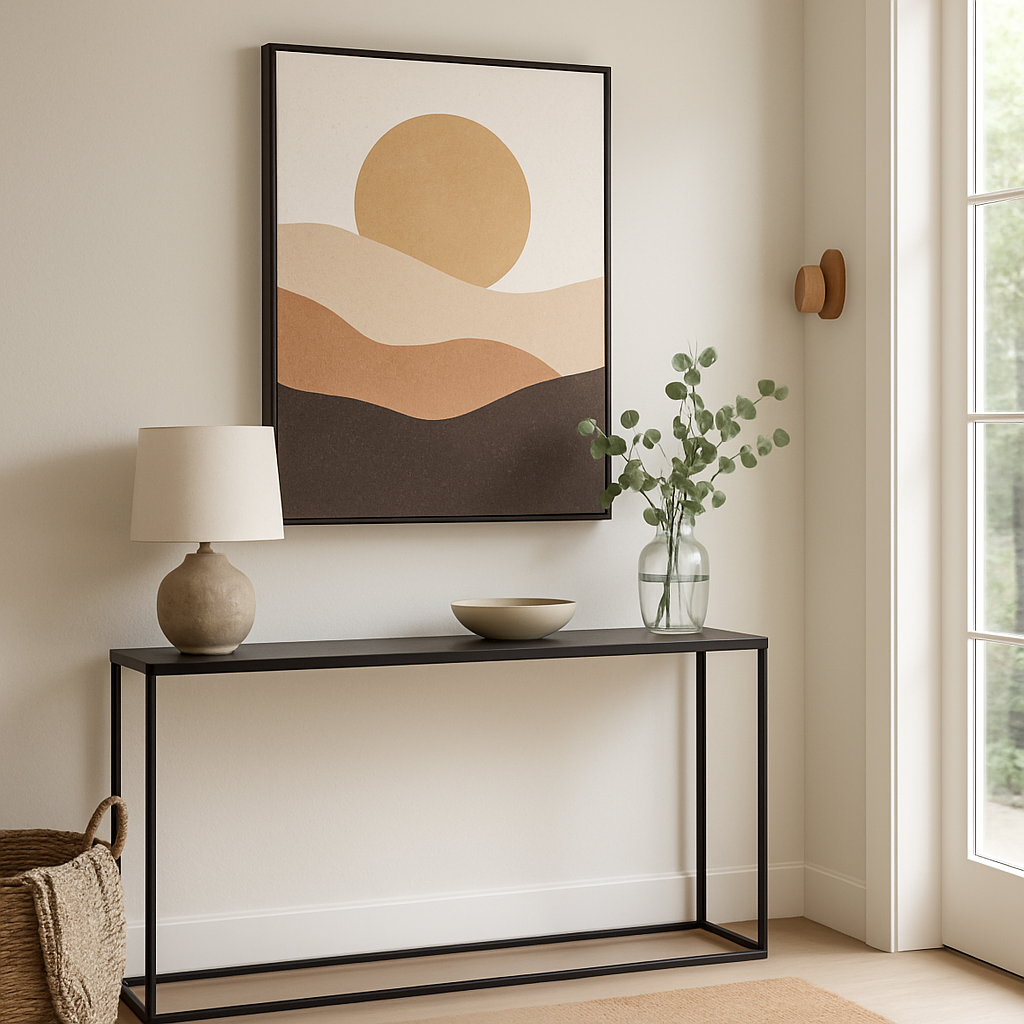
In home offices, where focus and inspiration are key, medium prints (16″x20″) at eye level can enhance concentration while adding personality.
Bathrooms, typically the smallest rooms in the house, call for smaller prints (5″x7″ or 8″x10″) that don’t overwhelm the limited wall space. Consider groupings on shelves or small gallery arrangements that add character without cluttering these functional spaces.
How to choose the right art print size: best practices and pro tips
Selecting the perfect dimensions for your artwork involves more than just eyeballing a space. Follow these practical strategies to ensure your prints enhance your home beautifully.
Measuring for success
Start by measuring both your wall space and any furniture the art will hang above. For blank walls, your artwork should ideally fill 60-75% of the available width. When placing art above furniture, the golden rule suggests selecting pieces that are two-thirds to three-quarters the width of the furniture below.
Height placement matters significantly too. The center of your artwork should hang at approximately 57-60 inches from the floor – this is the average human eye level used by most galleries and museums. When hanging above furniture, position the bottom edge of your frame 6-12 inches above the furniture to create visual connection without awkward spacing.
Visualization techniques
Before committing to a purchase, use painter’s tape or cut paper templates to outline your potential artwork on the wall. Living with these outlines for a few days gives you a realistic sense of how the final pieces will impact your space and whether the size feels appropriate for the room.
Consider the viewing distance as well. Larger rooms where you’ll primarily be viewing the artwork from a distance call for bigger pieces with bolder elements. In contrast, smaller spaces where you’ll be closer to the art allow for more detailed, intricate work in smaller formats.
When to use multiple pieces
Gallery walls work wonderfully when you have several smaller pieces you’d like to display or when you want to fill a large wall without the expense of oversized art. For cohesive gallery arrangements, maintain consistent spacing between frames (typically 2-3 inches) and unify the collection through similar frames, themes, or color palettes.
Don’t be afraid to mix orientations – combining portrait (vertical), landscape (horizontal), and square formats creates visual interest and dynamic energy within your arrangement.
Art print types and their impact on size selection
The medium of your print significantly influences how it occupies and interacts with your space. Different print types create varying visual impacts, even at identical dimensions.
Canvas prints
Canvas prints typically extend from the wall by about 1.5 inches, creating a three-dimensional effect. This depth gives them a substantial presence that often allows them to work well at slightly smaller sizes than would be required for flat prints. Canvas particularly enhances large format artwork, as the textural element adds richness to bold images and abstract pieces.
Framed and matted prints
Adding frames and mats substantially increases the wall footprint of your artwork. A standard mat typically adds 2-3 inches to each dimension, while frames add another 1-2 inches all around. This means an 11″x14″ print with matting and framing might actually occupy about 17″x20″ of wall space. The additional size creates more presence, allowing smaller original prints to command more attention.
The style of your frame also impacts perception – thin modern frames minimize size increase while ornate, wider frames can dramatically expand the visual footprint of the piece.
Metal and acrylic prints
Contemporary metal and acrylic prints offer sleek, frameless options that maintain a minimal wall footprint. These modern formats tend to work well in clean, minimalist spaces where the artwork itself can be the focus without additional framing elements. Because they reflect light differently than traditional prints, they often create a more dynamic presence even at modest sizes.
Unframed posters
Standard posters and prints without framing create the smallest wall footprint but may appear unfinished without proper presentation. If choosing unframed pieces, consider larger sizes to ensure they command appropriate attention and don’t appear as temporary placeholders.
Using art print sizes to create balance, proportion & visual interest
The dimensions of your artwork don’t just fill wall space – they actively shape how a room feels and functions. Thoughtful size choices create harmony and personality throughout your home.
Creating focal points
Large statement pieces naturally draw the eye and anchor a room. Position your most substantial artwork (24″x36″ or larger) on the wall you want visitors to notice first. This focal point technique works particularly well above sofas, beds, or mantels – places where people naturally direct their attention.
For maximum impact, allow statement pieces breathing room rather than crowding them with other décor elements. A single impressive piece often creates more drama than multiple competing artworks.
Enhancing room dimensions
Strategic print orientation can visually alter room proportions. In spaces with low ceilings, vertical prints draw the eye upward, creating the impression of height. For narrow rooms, horizontal pieces visually expand the width of the space.
In small rooms, consider using a single larger piece rather than many small ones, which can create visual clutter. A well-chosen medium-large print can paradoxically make a compact space feel more expansive by providing a clear focal point.
Layering for depth
Different print sizes create dimensional interest when thoughtfully combined. Try positioning smaller framed pieces (8″x10″) on floating shelves in front of a larger background print. This layering technique adds sophistication and depth to your walls while allowing you to showcase more of your collection.
For maximum versatility, build a collection that includes various sizes – perhaps several small (5″x7″), a few medium (11″x14″ to 16″x20″), and one or two larger pieces (24″x36″ or beyond). This variety allows you to refresh your displays without new purchases, simply by reconfiguring what you already own.
Gallery wall strategies
When creating gallery walls, vary your print sizes for an organic, collected look. Begin with a larger anchor piece (typically 16″x20″ or larger) and build around it with progressively smaller works. Maintain enough similarity in frame style or artwork theme to create cohesion while allowing size variation to add visual rhythm.
For more formal spaces, symmetrical arrangements with prints of identical or very similar sizes create an elegant, orderly impression. This approach works particularly well in dining rooms and formal living areas where a sense of balance reinforces the room’s function.
Conclusion
Selecting the perfect art print size is both science and intuition. While general guidelines suggest proportions relative to your furniture and wall dimensions, your personal response to a piece in your space matters most. The ideal size balances visibility from your typical viewing distance, proportion to surrounding elements, and the emotional impact you want the artwork to create.
Don’t be afraid to experiment and trust your eye. Sometimes a deliberately oversized piece creates delightful drama, while in other instances, a smaller, more intimate artwork establishes the perfect mood. The most successful homes mix different sizes thoughtfully, creating visual conversation between pieces while maintaining overall harmony. With the guidance provided here, you now have the tools to select print sizes that will enhance every room in your home with confidence and style.
FAQ
What are the most common art print sizes for home decor?
Common sizes include 5×7″, 8×10″, 11×14″, 16×20″, 18×24″, and 24×36″. These fit standard frames and are versatile for different rooms.
How do I choose the right size art print for above a sofa or bed?
The ideal width is about two-thirds to three-quarters the width of your furniture, and the art should hang 6–12 inches above it.
Should I use one large print or a gallery wall of smaller prints?
Use a large statement print to anchor spacious walls or create a gallery wall by arranging multiple small/medium prints for visual interest.
How does the print type (canvas, framed, etc.) affect the required size?
Frames and mats increase overall footprint; canvas works well for impact pieces; consider the total wall area including any framing.
Can I mix different art print sizes in one room?
Absolutely—mixing sizes adds depth and character. Just ensure there’s visual harmony in your arrangements.